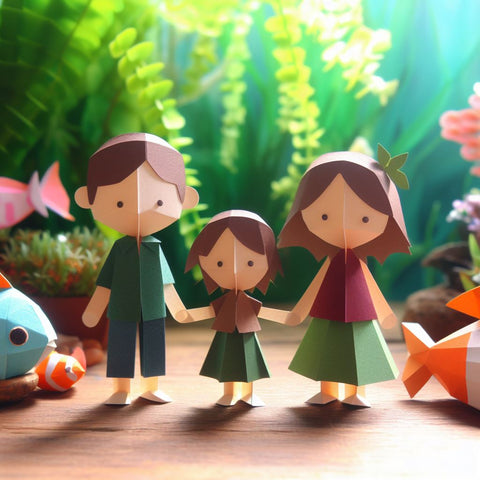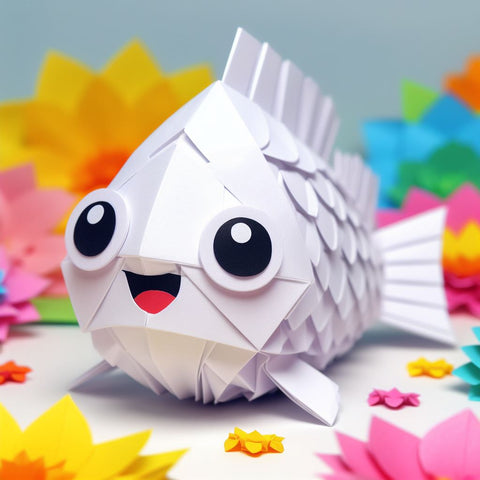The Allure of Aquaponics
Hello, aquaponic enthusiasts and green-thumbed readers! Today, we're taking a deeper dive into a topic that adds a touch of artistry and beauty to your aquaponic adventure: raising ornamental fish in your aquaponics setup. Imagine this: a mesmerizing underwater world where vibrant fish glide gracefully through crystal-clear waters while lush greenery thrives above, all within the confines of your very own living space. Intrigued? Let's embark on the delightful journey of incorporating ornamental fish into your aquaponic ecosystem.
The Allure of Ornamental Fish
For the uninitiated, aquaponics is a brilliant blend of aquaculture and hydroponics, creating a self-sustaining ecosystem where fish waste nurtures plants, and plants purify the water. But what if we told you that this enchanting harmony can transcend mere practicality? Enter ornamental fish, such as koi, goldfish, guppies, and even the surprising choice of tilapia, which add a touch of elegance and beauty to your aquaponic setup.

1. The Visual Feast: Aesthetic Value
Let's begin with the sheer beauty of ornamental fish. Their vibrant colors, intricate patterns, and graceful movements transform your aquaponics system into a living, decorative masterpiece. Picture the tranquility of watching these stunning fish glide through your tank while you savor the lush greens growing above. It's like having a piece of aquatic art right in your home or garden.
2. The Fish Gallery: Diverse Species
The world of ornamental fish is a tapestry of colors and shapes. From the regal koi with its magnificent patterns to the playful and ever-charming goldfish, and the tiny, colorful guppies, you have a smorgasbord of choices to tailor your aquaponic setup to your preferences. Whether you're a fan of bold and big or delicate and small, there's an ornamental fish to match your vision.
3. Education & Wonder
Here's a bonus: raising ornamental fish in aquaponics isn't just about aesthetics; it's also an educational journey. For children and students, it's a captivating lesson in biology, ecology, and environmental stewardship. Observing the life cycle and behavior of these fish can be an engaging and informative experience, fostering a deeper connection to the natural world.

Selecting Your Fish for Aquaponics
Selecting the right fish for your aquaponics system is crucial to ensure the health of both the fish and the plants. When choosing ornamental fish, you should consider factors such as size, temperament, compatibility with your chosen plants, water quality requirements, and aesthetic appeal.
Here are some popular choices:
| Koi | Goldfish | Tilapia | Guppies | Betta Fish | Catfish | |
|---|---|---|---|---|---|---|
| Size | Large (Can grow over 2 ft) | Medium (6-10 inches) | Medium to Large (12-18") | Small (1-2 inches) | Small (2-3 inches) | Medium to Large (12-24") |
| Temperament | Peaceful | Peaceful | Generally Peaceful | Peaceful | Aggressive | Generally Peaceful |
| Compatibility | Compatible with most plants | Compatible with most plants | May eat some plants | Compatible with most plants | Males are territorial. Females can also become territorial. | Compatible with most plants |
| Water Quality | Prefers cooler water | Tolerant of varying temps | Warmer water (75-85°F) | Tolerant of varying temps | Tropical (78-80°F) | Tolerant of varying temps |
| Feeding | Omnivorous | Omnivorous | Omnivorous | Omnivorous | Carnivorous | Omnivorous |
| Growth Rate | Moderate | Moderate | Rapid growth | Rapid growth | Moderate | Moderate to Rapid growth |
| Reproduction | Typically do not breed | Can breed under right conditions | Breed readily | Breed readily | Breed readily | Breed readily |
| Aesthetic Value | Striking colors and patterns | Varied colors and forms | Plain appearance | Colorful and small | Vibrant colors and long fins | Diverse appearances |
| Tank/Space Size | Requires a large tank/pond | Medium-sized tank/pond | Medium-sized tank/pond | Small to medium tank | Small tank | Medium-sized tank/pond |
| Lifespan | 20-30 years (with proper care) | 10-15 years (with proper care) | 5-7 years (varies) | 1-3 years (varies) | 2-4 years (varies) | 15-20 years (with proper care) |
When selecting your ornamental fish, the design of your system, and the plant species you intend to grow, it's crucial to consider compatibility. Some fish may have a penchant for nibbling on plant roots or disturbing the growing medium. Choose plant species that can coexist peacefully with your fish, just as you would seek out the ideal roommates for your aquaponic "apartment." Compatibility ensures that both your fish and plants can thrive without conflicts. Alternatively, build a system using hoses and pipes to ensure that the fish never come into contact with the leaves or roots.
Here's a comparison chart that outlines the characteristics and considerations for several different styles of aquaponics setups:
| Aquaponics Style | Description | Ideal Plants | Space Requirement | Complexity | Advantages | Considerations |
|---|---|---|---|---|---|---|
| Media-Based | Grow beds with a growing medium (e.g., gravel) | Lettuce, herbs, leafy greens | Moderate to Large | Moderate | - Simplicity - Versatility in plant types - Good for beginners - Natural filtration | - Periodic media maintenance - May not suit larger fruiting plants - Limited root space |
| Deep Water Culture | Plants in floating rafts on water surface | Larger plants (tomatoes, etc.) | Moderate to Large | Moderate | - High plant production - Efficient nutrient delivery - Suitable for larger plants | - Requires proper aeration - Continuous water flow - Maintenance of floating rafts |
| Nutrient Film Technique (NFT) | Thin nutrient film over plant roots | Herbs, lettuce, strawberries | Small to Medium | Moderate | - Water-efficient - Suitable for small spaces - Excellent for fast-growing crops | - Sensitive to power outages - Requires proper nutrient balance - Risk of root drying out |
| Vertical Aquaponics | Stacked growing towers or racks | Various (leafy greens, herbs) | Small to Medium | Moderate | - Space-efficient - Aesthetically pleasing - Maximizes vertical space | - May require additional lighting - Accessibility for maintenance - Limited root space |
| Ebb and Flow (Flood and Drain) | Grow beds that periodically flood and drain | Various (most crops) | Small to Large | Moderate | - Versatile - Suitable for many plant types - Good nutrient distribution - Oxygenation | - Requires proper flood and drain cycle - Maintenance of timers and pumps - Potential root zone issues |
| Hybrid Aquaponics | Combines aquaponics with other cultivation | Depends on hybrid components | Varies based on hybrid method | Varies based on hybrid method | - Versatility - Tailored to specific needs - Crop diversity - Flexible design | - Complexity depends on hybrid components - Requires knowledge of both systems - Balancing needs |
The cornerstone of a successful aquaponics setup is water quality. Just as humans need a clean and comfortable environment to thrive, so do your ornamental fish. Regular monitoring of pH levels, temperature, and water parameters like ammonia, nitrite, and nitrate is crucial. These factors are akin to the delicate balance of minerals and pH in a spa's water, ensuring that your finned friends are living in a stress-free aquatic paradise.
Here are key practices to keep up water quality in your aquaponics system:
-
Monitoring Water Parameters:
- Regularly test water parameters such as pH, ammonia, nitrite, nitrate, temperature, and dissolved oxygen. Monitoring helps you catch any imbalances or issues early.
-
Maintaining pH Levels:
- Maintain the pH level within the optimal range for both your fish and plants. Generally, a pH range of 6.8 to 7.2 is suitable for most aquaponics setups.
-
Ammonia Control:
- Ammonia is produced as fish excrete waste. Beneficial bacteria convert ammonia into nitrite and then nitrate. To control ammonia levels:
- Avoid overfeeding your fish.
- Ensure adequate biological filtration through the growth of beneficial bacteria.
- Adequately stock your fish tank relative to the size of the system.
- Ammonia is produced as fish excrete waste. Beneficial bacteria convert ammonia into nitrite and then nitrate. To control ammonia levels:
-
Nitrate Management:
- Nitrate is the end product of the nitrogen cycle and serves as a nutrient source for plants. High nitrate levels are typically not harmful, but it's important to ensure that they don't become excessive.
- Regularly monitor nitrate levels.
- Adjust feeding rates and fish stocking density to maintain nitrate levels within the desired range for plant growth.
- Nitrate is the end product of the nitrogen cycle and serves as a nutrient source for plants. High nitrate levels are typically not harmful, but it's important to ensure that they don't become excessive.
-
Oxygenation:
- Proper oxygenation is essential for the well-being of fish and beneficial bacteria. Ensure sufficient aeration and water movement.
- Use airstones, diffusers, or water pumps to maintain oxygen levels.
-
Temperature Control:
- Maintain water temperatures within the optimal range for both your fish and plants. Different fish species have different temperature preferences.
- Consider using heaters or coolers as needed to regulate temperature.
-
Fish Health:
- Monitor your fish for signs of stress or illness. Healthy fish produce less waste and contribute to better water quality.
- Quarantine new fish before introducing them to your system to prevent disease transmission.
-
Biofiltration:
- A well-established biofilter, typically in the grow beds or a separate filter tank, is essential. This filter hosts beneficial bacteria that convert ammonia and nitrite into nitrate.
- Ensure good water flow through the biofilter media for efficient bacterial growth.
-
Regular Cleaning:
- Periodically clean and maintain the grow beds, removing any excess debris or dead plant material.
- Clean filters, if used, to prevent clogs and maintain efficient water flow.
-
Water Changes:
- In some cases, partial water changes may be necessary to dilute accumulated substances and maintain water quality.
- Use dechlorinated water when conducting water changes.
-
Minimize Chemical Inputs:
- Avoid the use of chemicals, pesticides, or non-aquaponic fertilizers that can disrupt the natural balance of the system.
-
Plant Health:
- Healthy plants help remove excess nutrients from the water, contributing to water quality. Ensure your plants are thriving and free from disease.
-
Fish to Plant Ratio:
- Maintain an appropriate fish to plant ratio to ensure that the plants can utilize the nutrients produced by the fish.
In the world of aquaponics, every day presents an opportunity to learn and grow, both as a gardener and as a steward of a thriving ecosystem. It's an educational journey that might require a bit of tweaking and fine-tuning along the way.
Whether you choose to raise ornamental or edible fish, aquaponics offers a fascinating and rewarding journey into the world of sustainable gardening. It's a dynamic and educational experience that allows you to cultivate both fish and plants in a harmonious ecosystem. Whether your goal is to enjoy the beauty of ornamental fish or harvest fresh and healthy produce, remember that the well-being of your fish remains central to the success of your aquaponics venture. By prioritizing their health and happiness, you'll not only create a thriving environment but also embark on a fulfilling and sustainable gardening journey.

